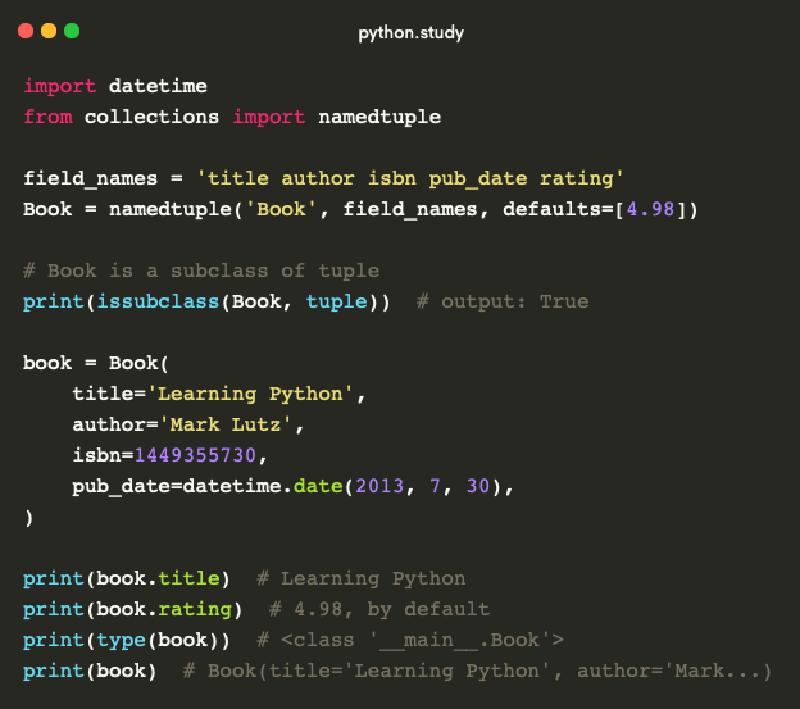Dataclasses are simple classes that generally only have a set of fields, without additional functionality (methods). Dataclasses are similar to structures in the C language - a composite data type that encapsulates a set of values of different types without hiding them.
On the one hand, a data class can be represented in Python as an ordinary class.
But this requires the programmer to perform routine actions: defining the __init__, __str__, comparison methods __eq__, etc.
In Python, you can create a data class much easier. Let’s consider 4 approaches to this: from simple to most powerful.
Approach 1. Named tuples collections.namedtuple
import datetime
from collections import namedtuple
field_names = 'title author isbn pub_date rating'
Book = namedtuple('Book', field_names, defaults=[4.98])
# Book is a subclass of tuple
print(issubclass(Book, tuple)) # output: True
book = Book(
title='Learning Python',
author='Mark Lutz',
isbn=1449355730,
pub_date=datetime.date(2013, 7, 30),
)
print(book.title) # Learning Python
print(book.rating) # 4.98, by default
print(type(book)) # <class '__main__.Book'>
print(book) # Book(title='Learning Python', author='Mark...)
collections.namedtuple is a factory that creates subclasses of tuple, as indicated by issubclass.
We can access data fields by name (book.title), and this will be the same for all data classes in the future.
In addition to the useful __str__ method, which outputs a good representation of the object, we also get a meaningful __eq__ method.
Approach 2. Typed named tuples typing.NamedTuple
import datetime
from typing import NamedTuple
class Book(NamedTuple):
title: str
author: str
isbn: int
pub_date: datetime.datetime
rating: float = 4.98
# Book is a subclass of tuple
print(issubclass(Book, tuple)) # output: True
book = Book(
title='Learning Python',
author='Mark Lutz',
isbn=1449355730,
pub_date=datetime.date(2013, 7, 30),
)
print(book.title) # Learning Python
print(book.rating) # 4.98, by default
print(type(book)) # <class '__main__.Book'>
print(book) # Book(title='Learning Python', author='Mark...)
As can be seen from the example, the use of the data class Book has not changed at all.
typing.NamedTuple offers the same functionality and additionally type annotations for each field.
The class syntax can be used with typing.NamedTuple starting from Python 3.6.
This allows you to add your own methods or override existing ones, for example, define your own __str__ method.
Book is still a subclass of tuple.
Approach 3. Decorator @dataclass
import datetime
from dataclasses import dataclass
@dataclass(frozen=True)
class Book:
title: str
author: str
isbn: int
pub_date: datetime.datetime
rating: float = 4.98
# Book is not a subclass of tuple
print(issubclass(Book, tuple)) # output: False
book = Book(
title='Learning Python',
author='Mark Lutz',
isbn=1449355730,
pub_date=datetime.date(2013, 7, 30),
)
print(book.title) # Learning Python
print(book.rating) # 4.98, by default
print(type(book)) # <class '__main__.Book'>
print(book) # Book(title='Learning Python', author='Mark...)
Again, the use of the data class Book has not changed. The class syntax is used, and you can define your own methods.
But there is a significant difference from the previous examples: the @dataclass decorator does not rely on inheritance from tuple.
And this is rather good! In addition, the @dataclass decorator takes several parameters, such as frozen, which configure the operation of the data class.
You can read about them in the documentation.
The @dataclass decorator can be used starting from Python 3.7. The dataclasses module was first described in PEP 557.
Approach 4. External package attrs
import datetime
from attrs import define
@define
class Book:
title: str
author: str
isbn: int
pub_date: datetime.datetime
rating: float = 4.98
# Book is not a subclass of tuple
print(issubclass(Book, tuple)) # output: False
book = Book(
title='Learning Python',
author='Mark Lutz',
isbn=1449355730,
pub_date=datetime.date(2013, 7, 30),
)
print(book.title) # Learning Python
print(book.rating) # 4.98, by default
print(type(book)) # <class '__main__.Book'>
print(book) # Book(title='Learning Python', author='Mark...)
The attrs package is external and is not included in the standard Python distribution. It must be installed separately. At first glance, there are no differences from @dataclass at all. Then why use an external package? Here’s how the attrs package developers answer this question.
Which approach to choose depends on the situation and preferences. Perhaps named tuples will be more than enough for you. But knowing about each of the approaches is useful in any case.
